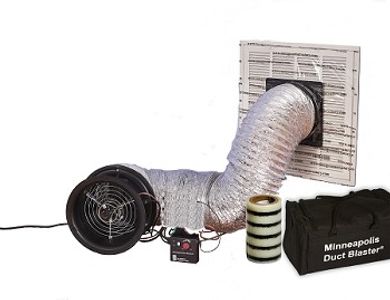Blower Door Testing
Residential Air Leakage
As of July 1st, 2017, all new residential homes in Florida must pass a Blower Door Test (also known as Envelope Leakage) to meet energy code. This includes single family and multi-family residences up to and including three stories. This testing is highly beneficial to ALL homeowners, not just for code!
Infiltration or uncontrolled air leakage into buildings is a result of the number and size of cracks and gaps in the building’s thermal envelope (its floor, walls, ceilings, windows, and doors) and the natural and mechanical air pressure “driving forces” that the building experiences. Natural driving forces include wind, “stack effect” (air motion in buildings related to indoor-to-outdoor temperature difference and height) and atmospherically vented appliances. Mechanical driving forces include fans (such as exhaust and air handler fans), duct leakage, and others. A blower door must be used in conjunction with a duct tester to measure Duct Leakage to the Outside.
To address the energy and indoor air quality impacts of air leakage in homes, the current Florida Building Code includes a building air leakage testing requirement for new Florida homes and stipulates both a maximum air leakage rate and, at the lower end, an air leakage rate “trigger” at which whole-house mechanical ventilation is required.
We are IDL Certified (Infiltration & Duct Leakage) by the Building Performance Institute, exceeding the FBC state requirements. Our Building Diagnostics are performed by Our Licensed Inspectors, not by sub-contractors.
New FBC Requirements
Additional Code Information
The 6th Edition (2017) Florida Building Code air leakage testing requirements are specified in Section R402.4.1.2 of the residential Energy Conservation volume. This code section stipulates maximum leakage rates, how the test is to be conducted, who can conduct the testing, reporting requirements, and at what point in construction the test can be performed:
“The building or dwelling unit shall be tested and verified as having an air leakage rate not exceeding seven air changes per hour in Climate Zones 1 and 2, and three air changes per hour in Climate Zones 3 through 8. Testing shall be conducted in accordance with ANSI/RESNET/ICC 380 and reported at a pressure of 0.2 inch w.g. (50 pascals). Testing shall be conducted by either individuals as defined in Section 553.993(5) or (7), Florida Statutes, or individuals licensed as set forth in Section 489.105(3)(f), (g) or (i) or an approved third party. A written report of the results of the test shall be signed by the party conducting the test and provided to the code official. Testing shall be performed at any time after creation of all penetrations of the building thermal envelope…”

"Although this is 'New' to FL, it has been mandatory in many states for over a decade."
Other Diagnostics

Duct Leakage Testing
Why Test Your Ducts for Leakage?
Most Florida homes have their duct work in the unconditioned attics. Properly sealed and insulated ducts deliver the expensive conditioned air where we want it, inside our living spaces. Code compliance credit for properly sealed ducts is only one of many reasons for this low-cost measure. There are two primary duct leakage tests that can be performed (See descriptions below). Here are just a few benefits of testing the duct work and properly sealing the leaks:
- Increased home comfort and reduced HVAC operating costs.
- Improved indoor air quality, reduced health & safety issues caused by duct leakage.
- Improved installation quality control, providing an optimal performing duct system.
- Better contractor performance as work is inspected & tested with flaws remediated.
- Increased eligibility for energy efficiency programs which require specific duct leakage results for program participation.

"Leaky ducts in your attic (Red) greatly reduce efficiency costing you money and comfort."
NEW FBC REQUIREMENTS
Additional Code Information
Duct leakage testing is described in the IECC (Section R403.3.3) for all new residential construction. This and other recent changes in the Florida Energy Code may require builders to re-evaluate energy efficiency measures included in their homes in order to pass code. One credit, the leak-free duct credit, provides a 9 percent benefit for code compliance. For comparative purposes, including this credit has about the same impact as raising the air conditioning (AC) system SEER rating from 13 to 15. However, verification is required by a state approved, qualified technician.
To receive the duct system credit, leakage must be less than 3 percent Total Duct Leakage (3 cfm/100 square feet), OR the leakage must be less than 9 percent Total Duct Leakage, and less than 3 percent leakage to unconditioned spaces (Outside Leakage). Since less than 3 percent Total Duct Leakage is extremely difficult to achieve (air handlers alone leak 1-3 percent), the second option, is the method more likely to be successful. The duct tester alone is used to measure Total Duct Leakage.
A blower door must be used in conjunction with a duct tester to measure Leakage to the Outside. The blower door-duct tester combination is required to test for the practical and achievable option. No substitutes for estimating duct leakage are allowed.

Duct "Leakage to the Outside" not only wastes conditioned air, but it increases home infiltration.
Copyright © 2017 Seaside Services Org., LLC - All Rights Reserved.

